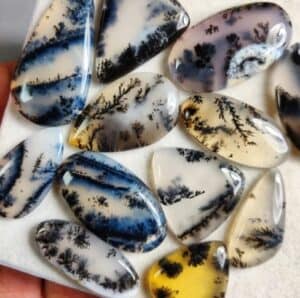There are a few gemstone varieties that have dendritic inclusions, dendritic opal is one of the well-known ones. This variety of opal contains dark inclusions that form incredible fern-like or tree-like patterns across the gemstone’s surface.
Dendritic opal is relatively abundant and a favorite among lapidary artists.

What Is Dendritic Opal?
This common opal is unlike the Austrailan opal because it shows no play-of-color and is characterized by the inclusions displaying branch-like or mossy patterns. Over the years the gem and mineral industry has given dendritic opal a few trade names such as “Mossy Opal” and “Moss Opal.”
The most common dendritic inclusions in this opal type are metallic oxides like iron and manganese. Dendritic opal is typically yellowish-brown or white with a resinous luster and opalescent sheen. The inclusions are dark-colored, found in brown, black, or dark green. While the stone is typically opaque, it can sometimes be translucent or a combination of both.

Colors of Dendritic Opal
Aside from the common white and yellowish-brown stones, dendritic opal can be found in several other colors and I’ve listed them below with examples to help make identifying which one you have easier.
- Green dendritic opal gets its green hue from the impurities in the opal.
- Yellow dendritic opal gets its yellow hue from the minerals in the dendrite.
- Purple dendritic opal is the rarest color to find in nature.
- Blue dendritic opal is hard to find but not the rarest color. These stones are not dark blue, slight bluish tint is a better description.
- Pink dendritic opal is hard to find and the stone doesn’t have a strong pink color, a slight pink tint is a better description.
- White dendritic opal is the most common and is translucent.

What Makes Dendritic Opal Dendritic?
According to Oxford Languages, the word Dendritic means;
“Having branched from resembling a tree” and “relating to a dendrite or dendrites.”
Dendritic opals wouldn’t be dendritic without dendrites and they’re fairly easy to identify because of the fern-like inclusions that naturally create the bold patterns.
Dendrites describe any mineral growing in a delicate and intricate branching pattern, including:
- Iron
- Manganese
- Copper
- Hydroxides
- Silver
- Gold
Dendrites are believed to form when there’s rapid crystalization and a limited supply of iron, manganese, copper, or hydroxides. These growing conditions can be compared to the frost on a windshield where the small frost flowers grow quickly, but because there’s too much moisture, they integrate, creating a solid sheet.
Every piece of dendritic opal is said to be one-of-a-kind because no two dendritic patterns are the same.

Where Does Dendritic Opal Come From?
Dendritic opal is easily accessible, which is one of the reasons it can be categorized as common. These gems can be found worldwide but most opal mines are in Australia. Common opals can be located in Mexico and the United States, with various deposits being mined in Guatemala, Brazil, Indonesia, Honduras, Russia, and Japan. They’re mined from sandstone, limonite, marl, rhyolite, and basalt rock fissures.
Because of the gemstone’s easy accessibility, it’s often more competitively priced in its raw form. The actual value stems from the stone’s characteristics, like its shape, if it has milky white coloring, and how defined and attractive the pattern is. Higher-value dendritic opal is found in Australia, along with rainbow opals.

Dendritic Opal vs. Dendritic Agate
Dendritic opal is often confused with a similar-looking stone, dendritic agate. If you’re shopping for a specific specimen, it’s good to know the differences between dendritic opal and dendritic agate.
While both dendritic opal and agate are types of silicates containing dark-colored tree-like inclusions, they differ in a few key ways. Let’s talk about it!
- Mineral Families – Dendritic opal is an opal variety, while dendritic agate is a banded chalcedony variety.
- Mineral Status – Dendritic agate is a mineral, while opal is a mineraloid. Mineraloids are mineral-like, but they lake crystalline structures. They also show a more comprehensive range of chemical compositions.
- Crystal Structure – Dendritic opal is amorphous or without a crystal structure. Dendritic agate has a hexagonal structure.
- Hardness – Dendritic opal scores between 5.5 to 6 on the Mohs mineral hardness scale, while dendritic agate is a 7.
Colors
Dendritic opals are typically a yellowish-brown or whitish color. The collection of dendrites contained contain streaks of dark green or deep brown- just like plants.
Dendritic agate or tree agate is translucent and can be found in a variety of colors, including grey, brown, black, and even colorless.
Dendritic opal might be a common opal variety, but every piece is unique, making them rarer than they may seem. The natural artistic quality embedded within each specimen is interesting and rather valuable.
Here’s an interesting fact, Dendritic opals sometimes get their inclusions from the presence of a dendritic agate during formation.

Which Finger To Wear A Mens Dendritic Opal Ring
There isn’t a hard and fast rule about which finger men should wear dendritic opal rings on. It’s been said that traditionally, these rings were worn on the ring finger of the dominant hand. Whichever finger you choose, it’s best to avoid wearing this type of opal alongside a wedding band with diamonds or sapphires. This is because dendritic opal is somewhat soft, and when it rubs against a harder ring band, it can become damaged.
- Identify Enstatite - March 12, 2024
- Identify Cerussite - March 3, 2024
- Identify Bytownite - February 18, 2024
